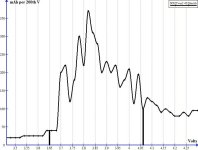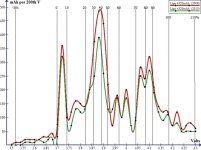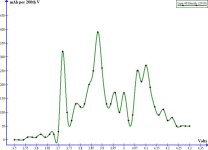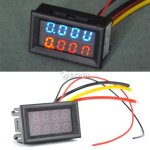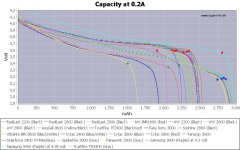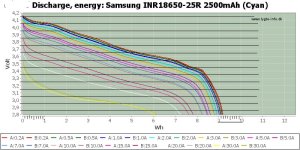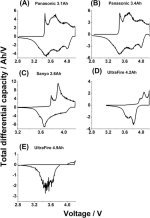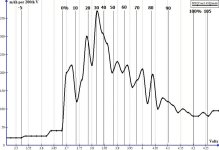Mapped Cells ... Round-up
2004 & 2006 Dell laptop recycled LiPo - 3.7V 4320mAh (2p) cells
These cells have remarkable durability and resistance to "age deterioration"
Unique, so far, is the severe dip in capacity near 4.05V followed by the impressive capacity bulge between 4.10-4.15V!
Excellent QC, cells in pack retaining equal capacity and "bleed down".
8-10 years old ... 500++ cycles 7000+ miles ... with still ~50% original capacity
(
Note: C rate seems to diminish equally with capacity! - C Rate seems tied to actual, rather than original, capacity.)
"Optimal" voltages rated at:
>3.75-4.15V best usable capacity ~150% usable cycles
>3.75- 4.02 = maximum life ~400% usable cycles
Sanyo 2600mAh (3.6V 5200mAh -2p)
Very common
Quality varies, Some batches display good pack equalization, other batches exhibit 1 pair cells, each pack, with severe "self discharge"
"Optimal" voltages rated at:
>3.70-4.05V best usable capacity ~300% usable cycles
>3.70-3.90V maximum life 800% usable cycles
2008 & 2010 Dell laptop recycled LiPo - 3.7V 4320mAh (2p) cells
Somewhat different formulation than the 2004-2006 version
Most noticeable is the capacity shift towards 3.70V
"Optimal" voltages rated at:
>3.70-4.15V best usable capacity ~150% usable cycles
>3.70-4.02V maximum life ~400% usable cycles
Finally tested up some RC Lipo ...
WinForce 3.7V 5700mAh (20C) RC LiPo
Most remarkable is the expansive voltage range of good capacity
"Optimal" voltages rated at:
>3.55-<4.20V best usable capacity ~100% usable cycles
>3.55-3.90V maximum life ~800% usable cycles
(These cells look to be "the perfect" specimens for a 3.90V charge limit ... ~70% capacity with 800% usable cycles! - age deterioration unknown?)
Winners Circle 3.7V 2000mAh 10C) RC LiPo
Solid capacity with no drastic capacity dips
Several years old with minimal cells gone bad(12 3s packs with 0% self discharging cells!)
"Optimal" voltages rated at:
>3.70-4.15V best usable capacity ~150% usable cycles
>3.70-3.95V maximum life >500% usable cycles
My purpose in mapping is to determine voltage regions for most efficient use combined with maximum lifespan.
Best exampled is that deep discharges "stress" cells with a miniscule capacity addition.
Every brand - type - formulation of Lithium cell "maps" differently!




